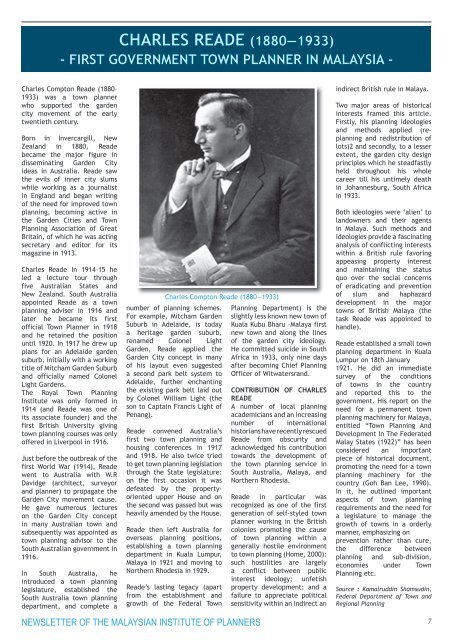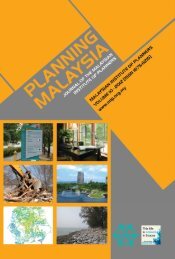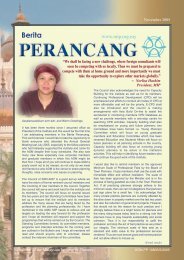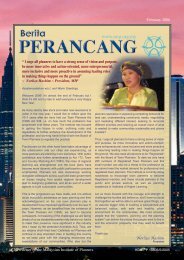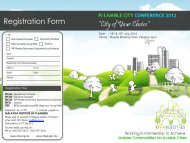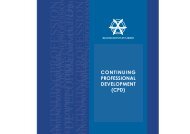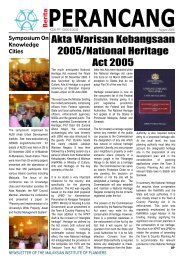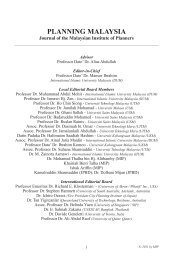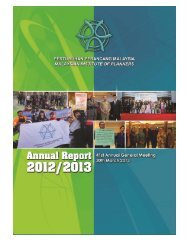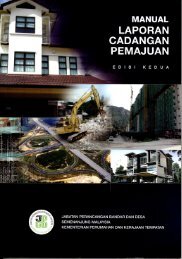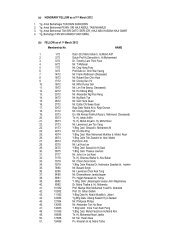mip patron tun dr mahathir mohamad honoured - Malaysian Institute ...
mip patron tun dr mahathir mohamad honoured - Malaysian Institute ...
mip patron tun dr mahathir mohamad honoured - Malaysian Institute ...
You also want an ePaper? Increase the reach of your titles
YUMPU automatically turns print PDFs into web optimized ePapers that Google loves.
CHARLES READE (1880—1933)<br />
- FIRST GOVERNMENT TOWN PLANNER IN MALAYSIA -<br />
Charles Compton Reade (1880–<br />
1933) was a town planner<br />
who supported the garden<br />
city movement of the early<br />
twentieth century.<br />
Born in Invercargill, New<br />
Zealand in 1880, Reade<br />
became the major figure in<br />
disseminating Garden City<br />
ideas in Australia. Reade saw<br />
the evils of inner city slums<br />
while working as a journalist<br />
in England and began writing<br />
of the need for improved town<br />
planning, becoming active in<br />
the Garden Cities and Town<br />
Planning Association of Great<br />
Britain, of which he was acting<br />
secretary and editor for its<br />
magazine in 1913.<br />
Charles Reade In 1914–15 he<br />
led a lecture tour through<br />
five Australian States and<br />
New Zealand. South Australia<br />
appointed Reade as a town<br />
planning adviser in 1916 and<br />
later he became its first<br />
official Town Planner in 1918<br />
and he retained the position<br />
until 1920. In 1917 he <strong>dr</strong>ew up<br />
plans for an Adelaide garden<br />
suburb, initially with a working<br />
title of Mitcham Garden Suburb<br />
and officially named Colonel<br />
Light Gardens.<br />
The Royal Town Planning<br />
<strong>Institute</strong> was only formed in<br />
1914 (and Reade was one of<br />
its associate founder) and the<br />
first British University giving<br />
town planning courses was only<br />
offered in Liverpool in 1916.<br />
Just before the outbreak of the<br />
first World War (1914), Reade<br />
went to Australia with W.R<br />
Davidge (architect, surveyor<br />
and planner) to propagate the<br />
Garden City movement cause.<br />
He gave numerous lectures<br />
on the Garden City concept<br />
in many Australian town and<br />
subsequently was appointed as<br />
town planning advisor to the<br />
South Australian government in<br />
1916.<br />
In South Australia, he<br />
introduced a town planning<br />
legislature, established the<br />
South Australia town planning<br />
department, and complete a<br />
Charles Compton Reade (1880—1933)<br />
number of planning schemes.<br />
For example, Mitcham Garden<br />
Suburb in Adelaide, is today<br />
a heritage garden suburb,<br />
renamed Colonel Light<br />
Garden, Reade applied the<br />
Garden City concept in many<br />
of his layout even suggested<br />
a second park belt system to<br />
Adelaide, further enchanting<br />
the existing park belt laid out<br />
by Colonel William Light (the<br />
son to Captain Francis Light of<br />
Penang).<br />
Reade convened Australia’s<br />
first two town planning and<br />
housing conferences in 1917<br />
and 1918. He also twice tried<br />
to get town planning legislation<br />
through the State legislature:<br />
on the first occasion it was<br />
defeated by the propertyoriented<br />
upper House and on<br />
the second was passed but was<br />
heavily amended by the House.<br />
Reade then left Australia for<br />
overseas planning positions,<br />
establishing a town planning<br />
department in Kuala Lumpur,<br />
Malaya in 1921 and moving to<br />
Northern Rhodesia in 1929.<br />
Reade’s lasting legacy (apart<br />
from the establishment and<br />
growth of the Federal Town<br />
Planning Department) is the<br />
slightly less known new town of<br />
Kuala Kubu Bharu –Malaya first<br />
new town and along the lines<br />
of the garden city ideology.<br />
He committed suicide in South<br />
Africa in 1933, only nine days<br />
after becoming Chief Planning<br />
Officer of Witwatersrand.<br />
CONTRIBUTION OF CHARLES<br />
READE<br />
A number of local planning<br />
academicians and an increasing<br />
number of international<br />
historians have recently rescued<br />
Reade from obscurity and<br />
acknowledged his contribution<br />
towards the development of<br />
the town planning service in<br />
South Australia, Malaya, and<br />
Northern Rhodesia.<br />
Reade in particular was<br />
recognized as one of the first<br />
generation of self-styled town<br />
planner working in the British<br />
colonies promoting the cause<br />
of town planning within a<br />
generally hostile environment<br />
to town planning (Home, 2000):<br />
such hostilities are largely<br />
a conflict between public<br />
interest ideology; unfetish<br />
property development; and a<br />
failure to appreciate political<br />
sensitivity within an indirect an<br />
indirect British rule in Malaya.<br />
Two major areas of historical<br />
interests framed this article.<br />
Firstly, his planning ideologies<br />
and methods applied (replanning<br />
and redistribution of<br />
lots)2 and secondly, to a lesser<br />
extent, the garden city design<br />
principles which he steadfastly<br />
held throughout his whole<br />
career till his untimely death<br />
in Johannesburg, South Africa<br />
in 1933.<br />
Both ideologies were ‘alien’ to<br />
landowners and their agents<br />
in Malaya. Such methods and<br />
ideologies provide a fascinating<br />
analysis of conflicting interests<br />
within a British rule favoring<br />
appeasing property interest<br />
and maintaining the status<br />
quo over the social concerns<br />
of eradicating and prevention<br />
of slum and haphazard<br />
development in the major<br />
towns of British Malaya (the<br />
task Reade was appointed to<br />
handle).<br />
Reade established a small town<br />
planning department in Kuala<br />
Lumpur on 18th January<br />
1921. He did an immediate<br />
survey of the conditions<br />
of towns in the country<br />
and reported this to the<br />
government. His report on the<br />
need for a permanent town<br />
planning machinery for Malaya,<br />
entitled “Town Planning And<br />
Development In The Federated<br />
Malay States (1922)” has been<br />
considered an important<br />
piece of historical document,<br />
promoting the need for a town<br />
planning machinery for the<br />
country (Goh Ban Lee, 1990).<br />
In it, he outlined important<br />
aspects of town planning<br />
requirements and the need for<br />
a legislature to manage the<br />
growth of towns in a orderly<br />
manner, emphasizing on<br />
prevention rather than cure,<br />
the difference between<br />
planning and sub-division,<br />
economies under Town<br />
Planning etc.<br />
Source : Kamalruddin Shamsudin,<br />
Federal Department of Town and<br />
Regional Planning<br />
NEWSLETTER OF THE MALAYSIAN INSTITUTE OF PLANNERS 7


